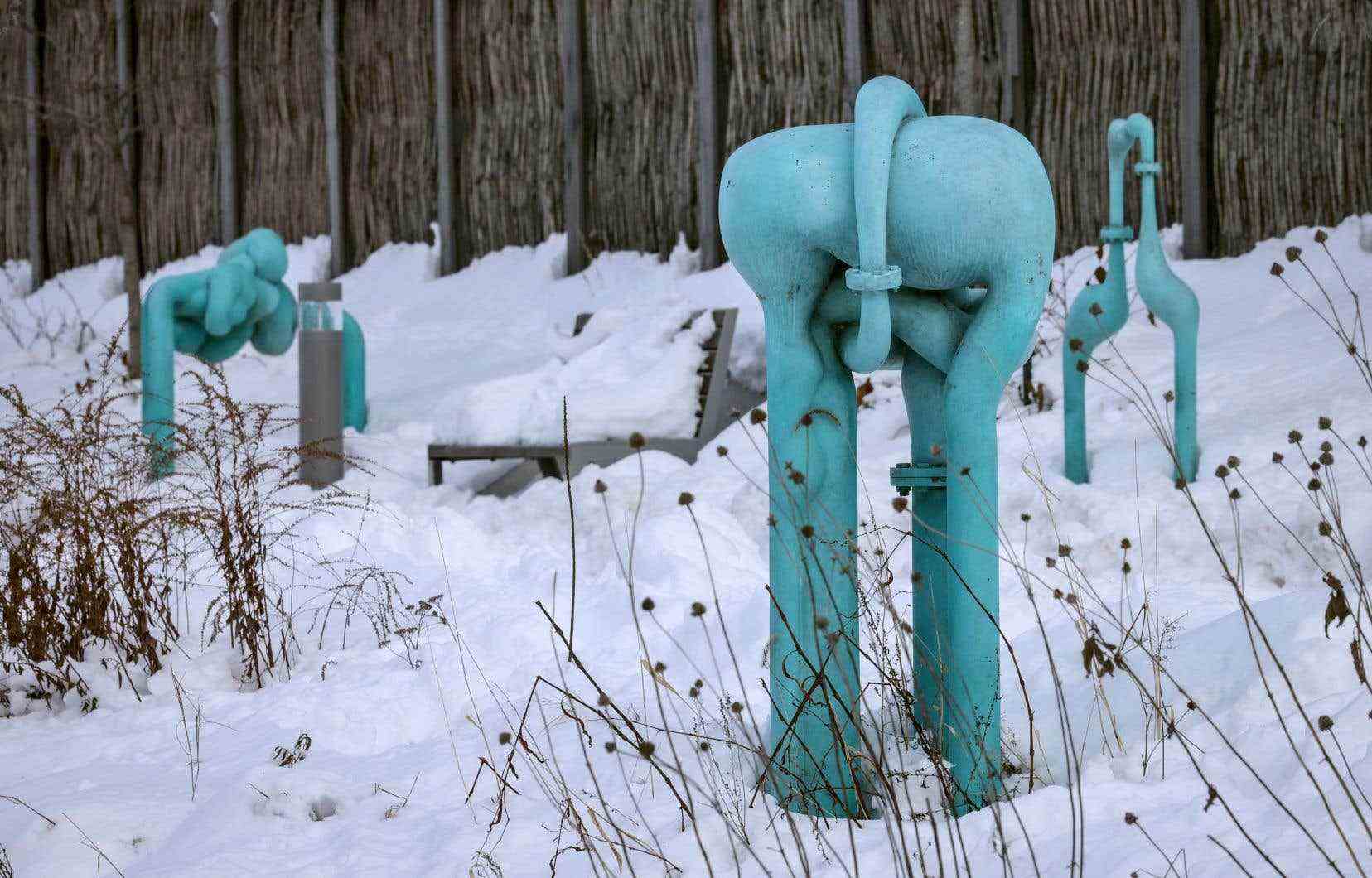There was a shower of murals in 2022 in Montreal: monumental ones, tributes to celebrities… Including the living Yannick Nézet-Séguin, in Ahuntsic. This surge of open-air painting, the high point of which was the media coverage of Salvation at Riopelle by Marc Séguin, could lead people to believe that public art comes down to 2D on a brick wall.
Sculpture, long alone on the ground, is nevertheless still part of urban revitalization plans. In 2022, three works appeared in connection with redevelopments operated by the City of Montreal. If we add similar cases from 2021, we double the number. Signs of renewal, visual landmarks in the landscape or gathering points, the sculptures brought together here remain little known.
Pipes or mushrooms
Sporophores, by Michel de Broin, is the best example. Installed in 2021, but never officially inaugurated, the most recent work by this figure in Montreal public art (Revolutions at Papineau metro or Dendrites on boulevard Robert-Bourassa, in particular) can be discovered during a stroll in an Outremont park in the shadow of the Université de Montréal — the new Campus MIL.
An aura of ambiguity, even mystery, surrounds Sporophores — a mushroom or “the visible part, the fruit and reproductive organ of an underground network of mycelium”, specifies by e-mail the artist. Already, the entity of the place is confusing, between “Parc Pierre-Dansereau” and “Promenade Camille-Laurin”. Then, Michel de Broin did not deliver an element, but a set of twelve small sculptures – the largest is 1.70 m. Sporophores is not the monumental public art cliché.
Its twisted and anthropomorphic shapes, its curves or the knots that entangle some of its tubes recall Broin’s signature. It turns often, at his place. And it brings to light otherwise secret, underground realities. These bronze sporophores, of an oxidized green, draw a (funny) pipe.
“I imagine the city’s underground infrastructures (sewers, water, electricity, telephone, heating, communication, fiber optics) as if it were a vast network of mycelium, insists the artist. My sculptures therefore imagine “sporophores” emerging from underground networks, retaining technical elements and taking on organic, half-animal, half-human forms. »
zero statue
There is reason to believe that a network of more sober public sculptures has taken place in 2021 and 2022. Between the not always straight lines of Michel de Broin and the arches and ovoids that have grown from Rosemont to the Old Port, the spirit is to suggestion, to visual breakthroughs. Heavy weights, massive shapes, literal propositions are not there.
Even in the case of homage and monumental works, the discourse remains open. Their effigies (2021), by Yann Pocreau, perhaps the best-known work among recent municipal commissions, salutes three foundresses of Montreal not by their portraits, but by aerial structures summarily resuming their religious identity. Its location, at the Grand Quay of the Port of Montreal, gives it its benevolent and welcoming feel.
Another tribute, this one to the Ukrainian community of Montreal, interlacing, by Giorgia Volpe, takes place at Ukraine Park, in Rosemont. Born from a competition launched in 2020, long before the war which put the Slavic country on everyone’s lips, the sculpture is similar to an egg, an object of offering in Ukrainian culture. It was produced with the collaboration of the target group, like other works in the municipal collection (the bow by Michel de Broin, for example, produced in 2009 under the initiative of the Chilean community).
You have to go around to see thatTracery, formed of intertwined ribbons rather than closed walls, multiplies the points of view. It therefore encourages a rapprochement between all, Ukrainians or not. And takes on great value in the current context.
Present echo of the past
Monumental, ethereal and yet potentially imperceptible, Knotweed, by Nadia Myre, stands on a green island at the corner of rue Laurier and chemin de la Côte-Sainte-Catherine. Even if pedestrians are rare there, this bronze structure invites you to approach it to see that its elements are carefully tied together.
From a distance, it looks like a tepee, or rather the frame of a tent whose covering would have flown away. Up close, it looks more like a net, an essential tool for First Nations, but not only. Nadia Myre, Montrealer of Algonquin origin, wanted to evoke both the path taken before the arrival of Jacques Cartier and the crossroads of cultures that took place and still takes place.
“The present echoes the past,” she states in her presentation text. Montreal is still a site where this exchange, now on an international scale, still constitutes a prevalent part of the metropolis’ identity. The use of a net encompasses this cultural diversity. »
In Griffintown, another monumental and aerial proposal, but not very intrusive, Reciprocities, by Marie-Michelle Deschamps, also unites the eras. Anchored in the new Place des Arrimeurs, at the corner of Ottawa, William and Guy streets, this first experience in public art by an artist known for her refined works responds elegantly to the program announced by the City, that of “requalifying a industrial sector into a new innovative district”.
First work of four produced as part of the Public Art Development Plan for the Ottawa Street Cultural Corridor, Reciprocities has several elements, including three arched steel tubes. A poetic evocation of a shipyard, the whole is completed by a floral piece, on the ground, reminiscent of milkweed, a native plant precious both yesterday and today, both for scientists and for monarch butterflies.
These works, whose total cost exceeds $2 million, prove that public art can still bring together and evoke a multitude of realities and has not once again become the celebration of individuals that emerged from the Victorian era.
